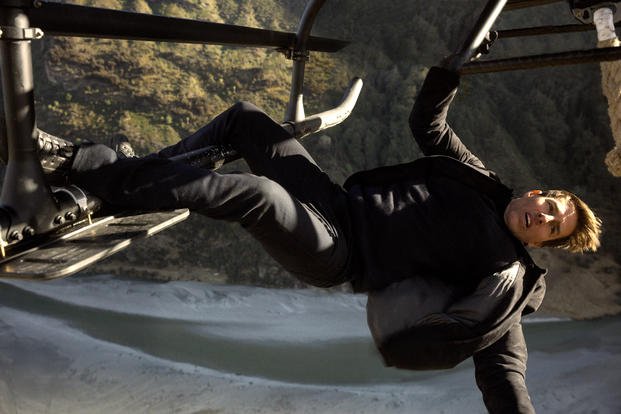"Mission: Impossible - Fallout" (out now on 4K, Blu-ray, DVD and Digital) might be the best in the series, and it certainly features the most exciting action sequences on film in 2018. This time, the crew faces the consequences of decisions made at the end of 2015's "Mission: Impossible - Rogue Nation."
Tom Cruise's Ethan Hunt may have shown more loyalty to his friends than the mission last time, and now the world is in nuclear peril. Director Christopher McQuarrie returns from "Rogue Nation" and becomes the first filmmaker to make two MI movies. That gives the story a bit more continuity than usual for this series and the attention to detail in the action sequences is perhaps its best ever.
Army veteran Marc Wolff was the aerial coordinator for the movie and oversaw production of the spectacular helicopter battle that gives the film its climax. Wolff has had a spectacular movie career that spans almost 50 years, with more than 150 movie credits. He's worked on "Black Hawk Down," a dozen James Bond movies, the "Star Wars" series, Harry Potter films, Marvel, the Christopher Reeve "Superman" movies, "Air America," and "Full Metal Jacket."
Wolff has a fascinating story and shared some amazing details about what it's like working with Tom Cruise and the mechanics of shooting an unforgettable helicopter scene.
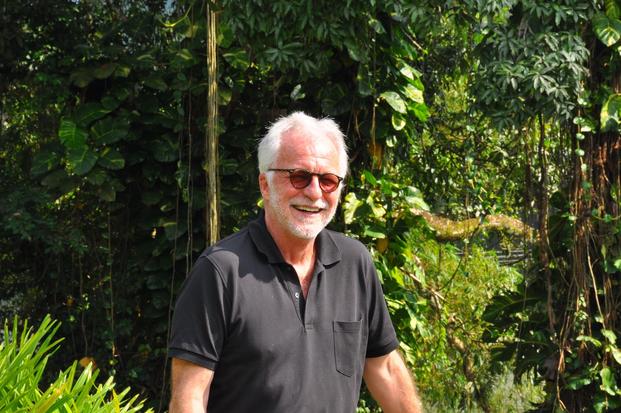
Please tell us about your military background.
I was drafted in 1966 into the American Army. After I finished my basic training, I was offered a couple of different courses, one of which was Army intelligence. I used to love the old Ian Fleming novels, so I thought, "That sounds interesting." Basically, there's two types of intelligence in the Army, trying to prevent the enemy knowing what you're doing and trying to find out what the enemy is doing. I thought that would be interesting.
To do that, I had to become an officer, so I went to Fort Benning in Georgia to Officer Candidate School on a six-month course. A friend of mine was there doing the same thing, we were in the same company, but he was going on to flight school instead of intelligence school.
Then we had these maneuvers where you play war games in the Okefenokee Swamp. For two weeks, we moved through this swamp. There's leeches and mosquitoes and snakes, and you're walking into water up to your chest; it wasn't very pleasant. At the end, they picked us up by helicopter and flew us back over what took two weeks to walk across. There's an English saying, the penny dropped in the slot. In the old days, you put the penny in the slot and the telephone worked.
So I said to this friend of mine, tell me more about this flight school, because it seems a lot better way to earn a living than walking through the swamps of Georgia, or Vietnam, or whatever. At one point toward the end of our course, we were allowed out on weekend leave and he took me flying in a little Piper Cherokee airplane. And I had a go at it and thought, "Oh, I could do this." This was in the middle of 1967, Vietnam was getting busy and helicopters were the new thing. So I applied to go to flight school instead of intelligence school and the rest is history, really.

How long were you in and where did you serve?
I served in Vietnam and West Germany. My basic branch was infantry, so when I finished in Vietnam, I was rotated back to ground duty and given command of a mechanized infantry company. I got promoted to captain quite quickly when I was 21. They gave me a command when I was 22 and I was a bit young, to be honest, for that kind of responsibility.
I wanted to fly. I didn't want to do other things and they didn't want me to fly anymore. Having spent all this money training me to fly, they only let me fly for about a year-and-a-half. After three years from the day that I finished flight school, I was allowed to get out. By that time, it was the end of 1971 and the war was winding down a little bit, and they let me go.
I liked it in Europe. My family originally came from Germany in the 1890s and 1910, so I stayed in Europe and England. They needed pilots, because they were expanding into the North Sea. So I started flying in England, and then I started doing films. After five years in England, I was allowed to set up my own business and do what I liked. I liked doing the film work, so in 1976, I started full-time flying for films.
I was lucky. In '76, I got a Bond film called "The Spy Who Loved Me," and then in '78 I did the first Superman film, and in '79, I did "The Empire Strikes Back." It took me about three years to really get established, and then after that I went on to do half a dozen Star Wars films and 12 James Bond films. So the military connection really got me into my career.
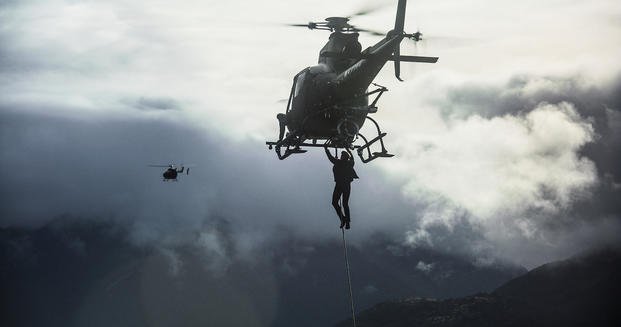
You've been involved with so many great action films over the last 30 years, but "Mission: Impossible - Fallout" has one of the most spectacular aerial sequences I think I've ever seen in a movie.
I had worked on three other "Mission: Impossible films" and I had worked on half a dozen films with Tom Cruise. But because the sequence was so important in the script, I had to interview for the job first.
I wasn't sure that I wanted to do it because I wasn't sure that I could control Tom enough to keep it safe and still make it spectacular. But I thought that I'd go through the process. Every one of my contemporaries was also up for the job, so I was a little bit competitive in that way and I thought, well, if I get the job, I can always walk away if I don't like it.
Tom actually convinced me to do the job. He thought that I knew how he worked more than anybody else, and the film was going to be based in London and I lived in London. I got the job because of that.
Tom is a fantastic character who is very well-prepared and who is diligent and conscientious and very skillful. I stayed, and it was a huge pleasure, a big challenge. There were lots of challenges because, although Tom had a professional license, he didn't have a great amount of experience. He had 200 hours in helicopters and a thousand hours of total flying experience.
To get a job flying in the winter in the mountains in New Zealand, doing the kind of flying we did, you'd need 5,000 hours or something before anybody would hire you. So I told New Zealand authorities, "Well, I want Tom to fly this helicopter and he's got 200 hundred hours' experience," and they sort of laughed.
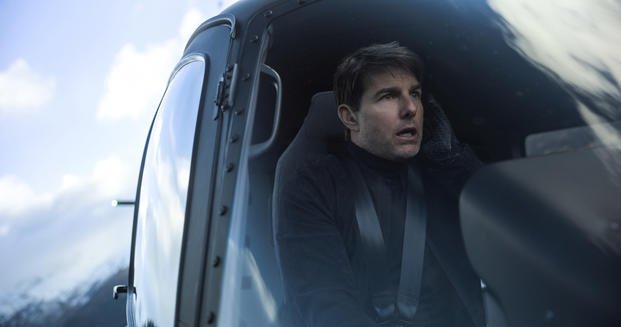
But I believed in him and he believed in me and we put it together. I taught him how to fly in formation and deal with the turbulence of other aircraft, other helicopters. I put him with a really good instructor pilot from Texas who improved his skill levels and expanded his experience. When we got to New Zealand, I put him with a mountain flying instructor I knew in New Zealand who has a special course with mountain flying. That prepared him for the conditions he was about to fly in, but also rounded out his total flying experience.
I suppose the other big challenge we had on the film was marking cameras on the exterior of the helicopters so that you could see that he was flying. There are not many places to attach these kind of things. I had a friend in California who does that for a living, and we designed and built a great, complex set of rigs that allowed us to put the camera wherever the director wanted on the outside of the helicopter.
Tom is very good with people, thanking people, and he always says good morning to you and he always says thank you. At the end of our shoot in New Zealand, they showed a short clip of everything we'd done to all the New Zealand crew as part of a thank you.
There was a fellow lying underneath the helicopter, taking the rigs off, called Greg. And I said, "Tom, I want you to meet Greg." Greg was one of the unsung heroes on this film. He worked 56 days in a row without a day off to get these helicopter rigs ready for us. Greg crawled out from under his helicopter and Tom did the selfies with Greg and thanked him profusely. To do [all] that in the short amount of time we had was a small miracle, because it would normally take about 18 months to get these rigs designed and built and checked for safety, and we had three months to do it. And a lot of that was because of people like Greg.

We changed the aircraft. We brought aircraft from the US, the two helicopters you see flying in the film were both American registered. The FAA has an aircraft category that allows us to change them to the experimental category, and that allowed us to do these rigs without too much advance paperwork.
We designed them properly and built them properly but we didn't have to go off of the long paperwork exercise that the FAA would normally require to put it under the standard category aircraft. Then we had to convince the New Zealand authorities to let us fly in experimental category. And they said, "Well, we'll agree if the Americans agree." And then the Americans said, "Well, we'll agree if the New Zealand authorities agree."
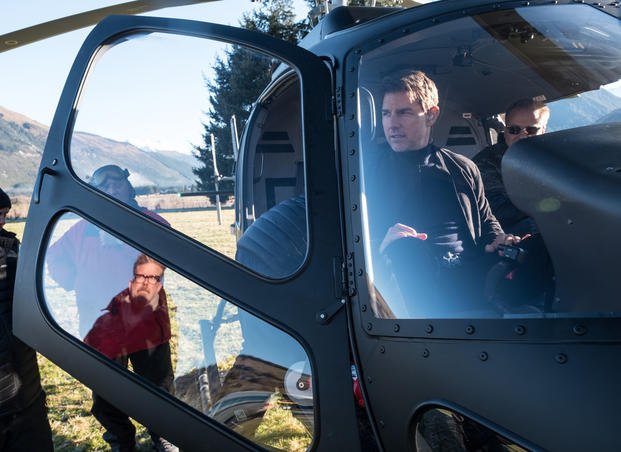
I know that Tom is very insistent on doing as many practical effects in a movie as possible. Compare this film to something else you might have worked on Would other people have just given in and done a lot more CGI?
Most studios don't allow an A-list star to do stunts. They pretend they do, the stars pretend they do, but they don't. They all have stunt doubles and they don't take that risk. And Tom does, Tom takes that risk. He believes that's part of his persona, it's part of why people go to see his films.
In terms of doing things practically, I think it really shows in this film that the only special effects that are used, really, are special effects that allow us to paint the wires out that are keeping him safe and things like that.
Even when they crash together, those are two real life-size helicopter fuselages. We swing them together on a crane and crash them together, but they're real life-size things. They're not something that's made up in a computer. The computer allows us to make it look more real, but we're not creating those effects in the camera, we're shooting real things.
Tom really climbed up into the bottom of the helicopter and he really fell back down and bounced on the bag. He did that in the winter when the temperatures were really cold and he's freezing and he's trying to climb up that rope with frozen hands. I think that shows on his face.

We built the rigs so we could see him doing that really close up on the helicopter. Normally, you'd be far away from that. The producers provided the money and the time to enable us to do that. When I first presented the budget to the producer for the rigs, it worked out to $250,000 and he fell off his chair and said, "You know I just did 'Dunkirk' and we put huge IMAX cameras on the wing of a Spitfire and it cost me $25,000. How could it possibly cost $250K?" We probably spent more like $300K in the end, and it was a huge success and everybody was really pleased.
Getting people to sign off on that and believe that you're going to produce it was one of the big challenges, because everyone is worried about it and there's not enough time. In the end, they have to trust you and let you get on with it. But it was a big ask, really.

Do you have advice for any veterans who are looking to get into your profession?
Do what I did. When they get out of the military, get some civilian flying experience. I had an interest in filming and storytelling and I loved doing that, compared to the other type of helicopter work. There's all types of work you can do, but I think you need an interest in films and you need to be able to travel around a lot, although pilots have to do that anyway.
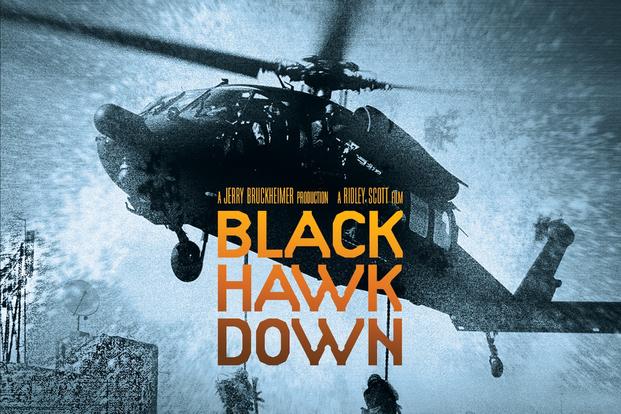
I came into "Black Hawk Down" when I was in my late 50's. All the pilots I was working with, they were really military pilots. You forget how young military pilots are. They were in their 20's and 30's. We had two of the most experienced military pilots still in service and they were in their early 30's. Because I was ex-military, I was like a godfather to them and so they would listen and work with me to do the things we needed them to do, things which were completely outside of the box, that they hadn't done before. We were trying to spin the helicopter and pretend the tail rotor had failed or got blown off by a missile.
That was a really interesting experience for me to go back to military life. We had a whole unit of military -- we had 200 soldiers and probably 11 helicopters, military helicopters. I don't think we could do that today, to be honest, because the political environment probably wouldn't allow us.
That was a fantastic experience to go back and remember those days of discipline. In the film industry, we work very carefully, and we risk assess everything we do, but we're not bound by the same protocols that the military are and the same standard operating procedures and the discipline of working in a very organized fashion.
We work in an organized fashion and we have our own operating manual that tells us how we should be operating, but the military takes that one step further. On "Black Hawk Down," I had to work within those parameters. I had to convince the military to do it my way when they had their own way to do it. Because if I couldn't do it my way, we wouldn't get the shots that Ridley Scott wanted to make the story work. At the same time, I had to satisfy the military that what we wanted to do, what I wanted them to do, was safe and was being controlled and fit within their own disciplines, their own protocols, their own procedures.
I also have done directing on the ground, and I do what's called second unit directing. I do action sequences on the ground, which I got into after directing sequences in the air. So I've become more of a filmmaker than a pilot nowadays, but I'm 71 years old and I've been flying for 50 years. So I guess it's not a bad thing to do a little less flying, but I still do it, I still love it, I'm still very busy. It's fantastic, really.

